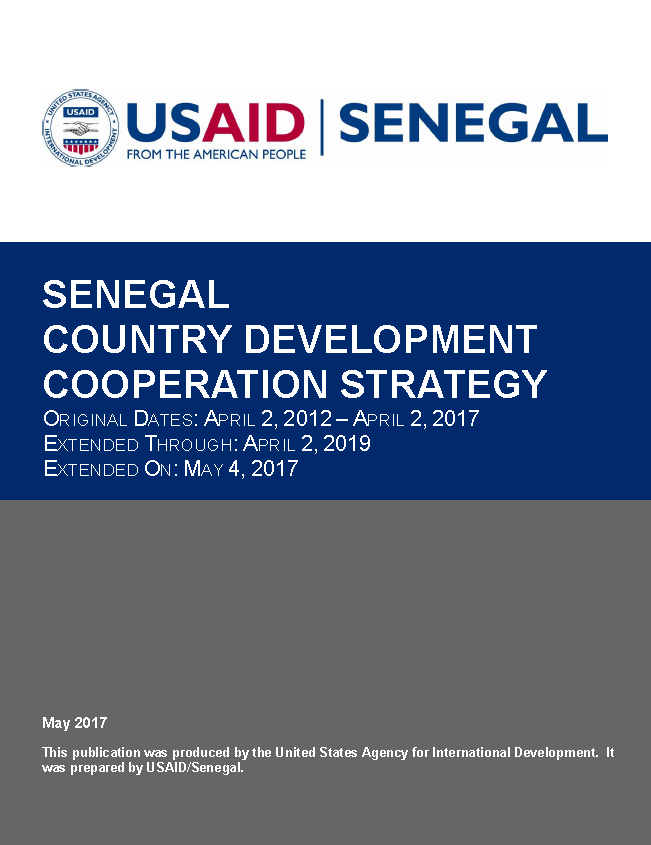DEVELOPMENT CONTEXT, CHALLENGES AND OPPORTUNITIES
Senegal CDCS 2012-2017 extended ![]() (pdf - 2 MB)
(pdf - 2 MB)
This Update to the USAID/Senegal CDCS documents changes in the Senegalese administration following 2012 presidential elections and aligns with Mission project design efforts. While fundamental development conditions and priorities in Senegal have not changed, Senegal has seen an improved enabling environment, evidenced by broader commitment to private sector-led growth, improved transparency and accountability, and quality Senegalese leadership in key sectors of USAID intervention. In addition, this Update incorporates new Agency initiatives and strategies, such as YALI, Global Health Security, Education, and Global Climate Change. The CDCS Update describes how USAID/Senegal programs focus on the poorest, highest need regions of Senegal, such as the marginalized southern Casamance region and the remote eastern corridor of the country. USAID/Senegal has increased its efforts to promote synergy across its sectors of intervention in targeted regions, in addition to integrated good governance principles across the entire foreign assistance portfolio. Finally, this Update reflects lessons learned by USAID/Senegal in recent years in strengthening and using local systems, including the use of government-to-government assistance and direct funding to local organizations.
Since independence from France in 1960, Senegal has evolved both politically and socially. Although the nation began as a highly centralized one-party state, the country is now firmly anchored in multi-party rule that counts more than 200 political parties. A diverse and vocal civil society, coupled with a culture of political engagement, promotes Government of Senegal (GOS) accountability. The press is considered to be free and there is a national Press Code that outlines the rights of journalists. In 2012, Senegalese citizens exerted their political might and ushered in a new era in the country’s political history. Macky Sall’s ascendance to the presidency has been marked by a commitment to economic development via a package of projects and reforms known as the Plan Sénégal Emergent (PSE). Presented in February 2014 to development partners, the PSE received widespread acclaim from technical and financial partners including the United States Agency for International Development (USAID), the International Monetary Fund (IMF) and European Union (EU) members states for its emphasis on reforms, including deficit reduction, public works, and investments in health and education.
Even with significant gains, social services access and quality within Senegal remains challenging. Despite near universal primary school enrollment, the quality of education remains low; illiteracy remains high and a low percentage of children complete basic education. Similarly, quality health care services are inaccessible for many Senegalese in rural and periurban areas. The degradation of the natural resources base, aggravated by human impact and the effects of climate change, is also among the country’s key challenges. The energy sector, burdened by aging equipment, has been unable to keep up with the increased demand. In addition, the 35 year-old Casamance conflict in southern Senegal continues to fester. Furthermore, Senegal’s regional context is not without challenges. Since 2010, the West African region has seen the evolution of Islamist extremism in Mali and the rise of the Boko Haram in Northern Nigeria. These problems are further complicated by the outbreak of Ebola in Sierra Leone, Liberia and neighboring Guinea in 2014.
However, Senegal, and specifically Dakar, is increasingly viewed among international businesses, international NGOs and to some extent foreign governments, as the political and commercial hub of West Africa. For its part, the government of President Sall has taken steps to reinforce this idea via several large-scale public works projects. In particular, the Autonomous Port of Dakar is undergoing major renovations to make it more suitable for ever-increasing trade with Europe, and completion of the Blaise Diagne Airport, currently under construction, is set for the latter half of 2015.
Read the full report [pdf]









Comment
Make a general inquiry or suggest an improvement.